Release notes - i2 Overwatch 1.1.0
This document provides an overview of the new features, system requirements, and known issues for i2 Overwatch 1.1.0.
Important notices
⚠️ Installation
i2 Overwatch requires that i2 Analyst's Notebook 10.1.0 has been installed with i2 Analyst’s Notebook 10.1.0 Test Fix 1 for Overwatch.
To install the i2 Overwatch, extract all components from the compressed file using the Extract All... option in the Windows right-click menu. Navigate to the root of the extracted folder and run setup.exe, then follow the installation prompts.
Deployment Options
i2 Overwatch can be deployed in a number of ways, depending on your requirements. The following deployment options are available:
If you require an Overwatch iBase deployment, a semantic library is provided that you can use to build an iBase that will work with Overwatch. This file is OverwatchSemanticTypeLibrary.mtc
If you require an Overwatch i2 Analyze deployment, an example schema is packaged under OverwatchSchema.xml, it uses the correct semantic ids that will be used by Overwatch, use this schema as a base line or use as inspiration.
If you run in a standalone environment, you can use the i2 Overwatch installer. No additional set up is required.
Conflicts with i2 Insights
Note that due to conflicting configurations, i2 Overwatch and the i2 Insights add-on cannot be installed simultaneously with Analyst's Notebook. The impact of this restriction on current users is under investigation, and use cases are being explored so a plan can be developed to address the conflict.
Features
Release highlights
The following new and updated features are available in this release:
| i2 Overwatch |
|---|
| NATO Standard - APP6-D symbol support |
| Map Drawing tools |
| Radii building from properties |
| Tile server Support |
| Map Layers |
| Marker scaling |
| Marker position updating |
| Polygon seeding |
| Print maps |
Release highlight details
NATO Standard - APP6-D symbology
In this release we now support NATO Standard APP6-D symbology. This also includes Graphical amplifiers on the symbols such as: Direction, speed, condition, mobility, echolen.
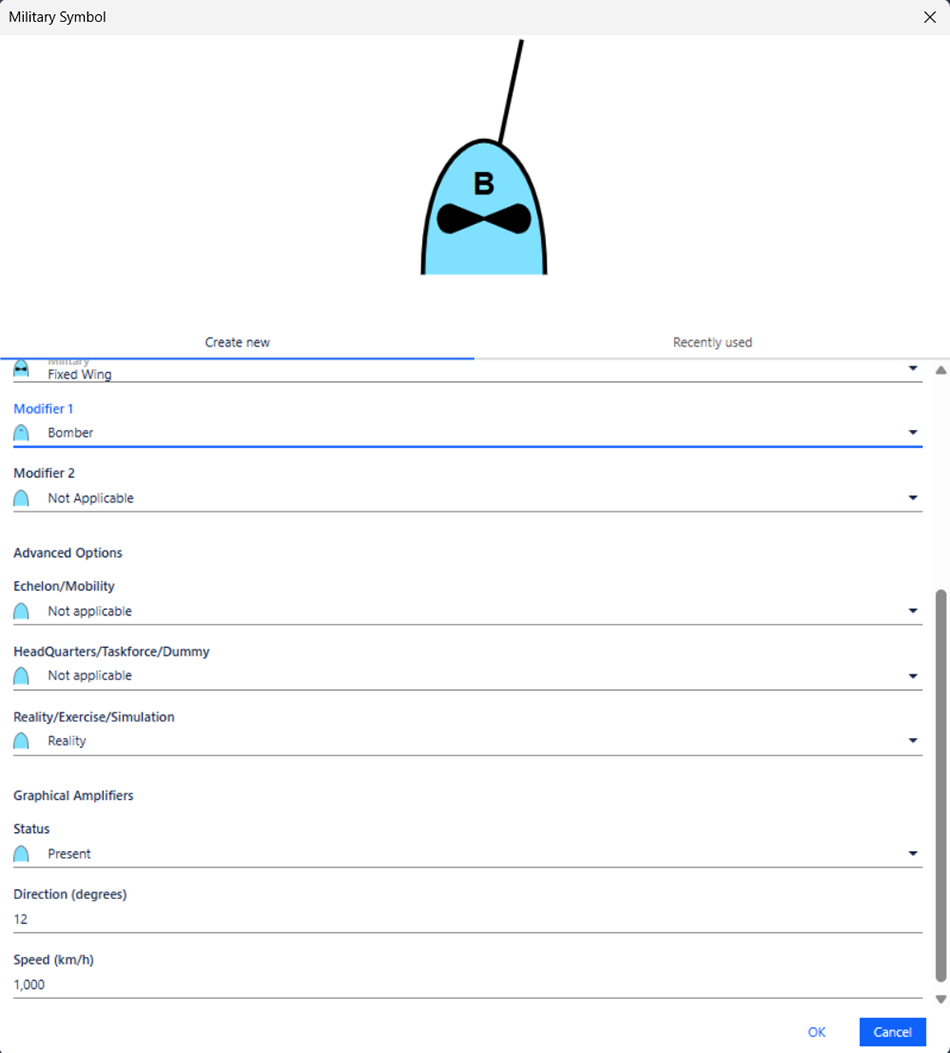
Drawing_Tools
This release now extends i2 Maps to include new drawing tools to support Polylines, Polygons and Rectangles. Shapes also support custom labels and measurements such as area, length, with the option to choose between unit systems. Shapes can also be styled with its fill opacity and color.
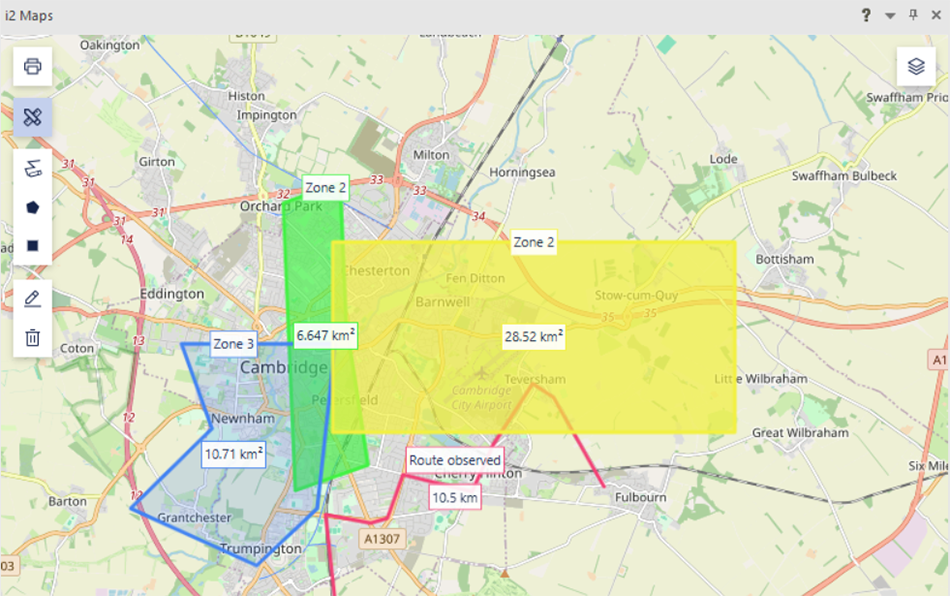
Radii
To represent ranges of equipment and units, we now support dynamic building of radii around a map marker using properties/attributes/fields that inherit or use our new semantic'Range'. We support as many radii as required.
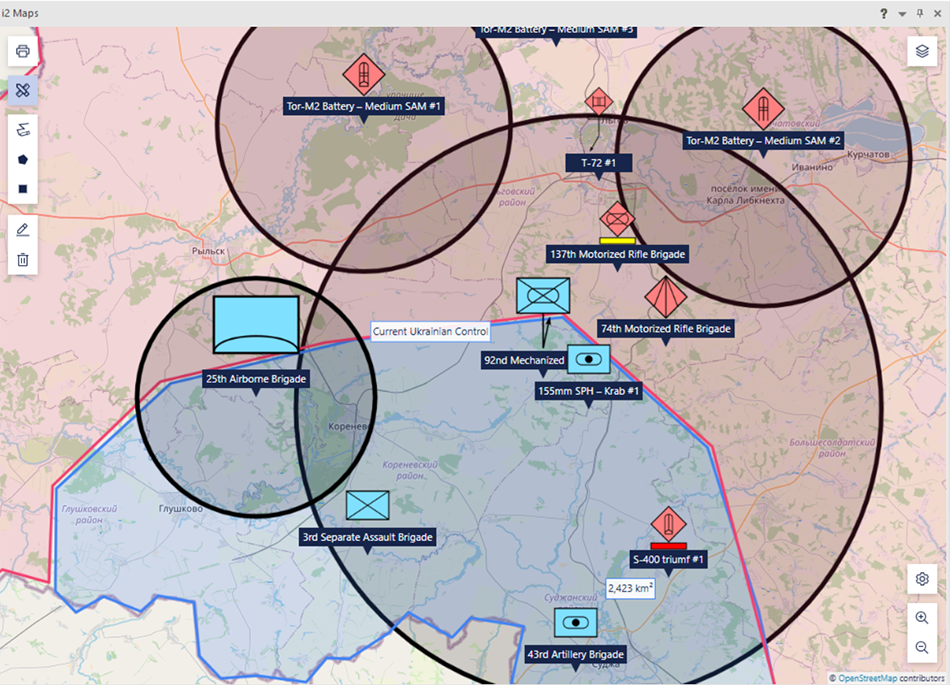
Tile_Server
We now support custom tile servers on i2 Maps. You can use the geospatial config file or i2 Maps settings to add any tile servers you have access to.
Layers
For ease of use and decluttering Layer support has now been added to Overwatch's i2 Maps. Layers can be created, renamed and removed. Layers can be nested and created from a selection. Layers dictate Z axis order on the map surface.
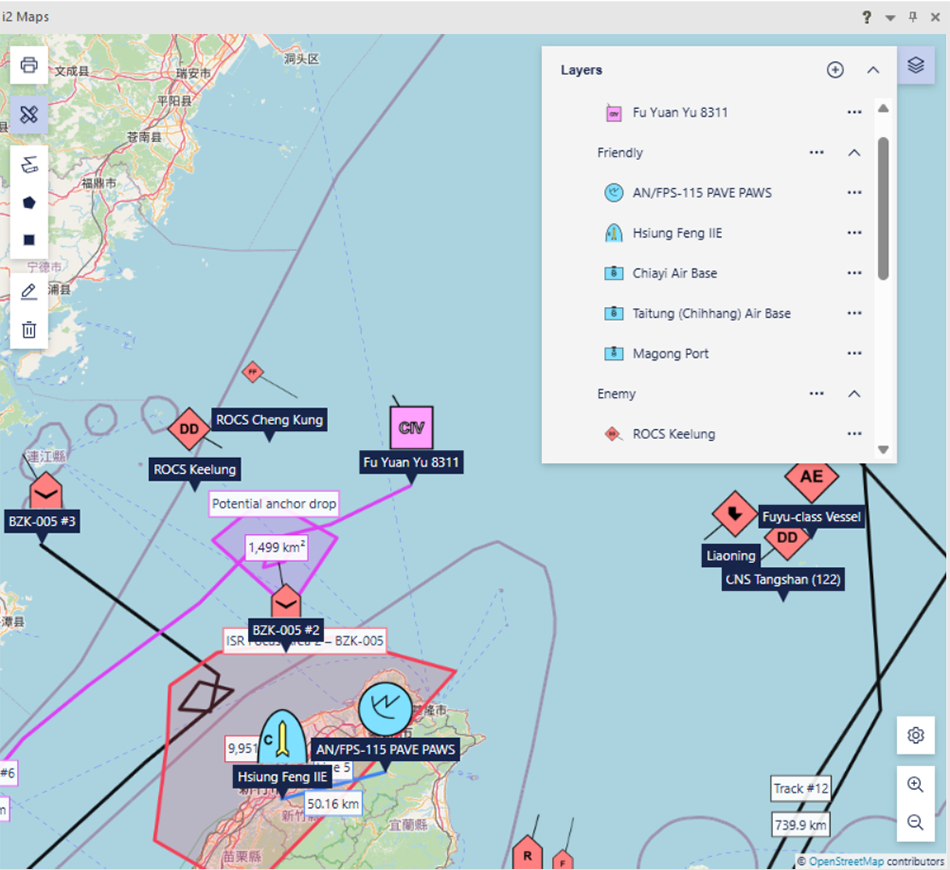
Creating large record layers
You can bulk add markers to a single layer on your map by following these steps:
- On your chart, select the entities you want to include in the new layer. Click and drag to highlight multiple entities, or hold down the
Ctrlkey (Cmdkey on Mac) while clicking on each entity. - To add to the map, right-click the selected entities and choose Add to Map from the context menu. A new layer is created and populated with the selected entities.
- To access layer options, click the three dots next to the layer name to open the Layer Options menu.
- Select Rename Layer from the Layer Options menu to change the layer name. Enter a name that accurately describes the layer's content.
Marker_scaling
With symbology, Markers can get quite complex or you might want to indicate importance of markers, so we have added support for markers to be scaled in size from 50% to 400% its default size.
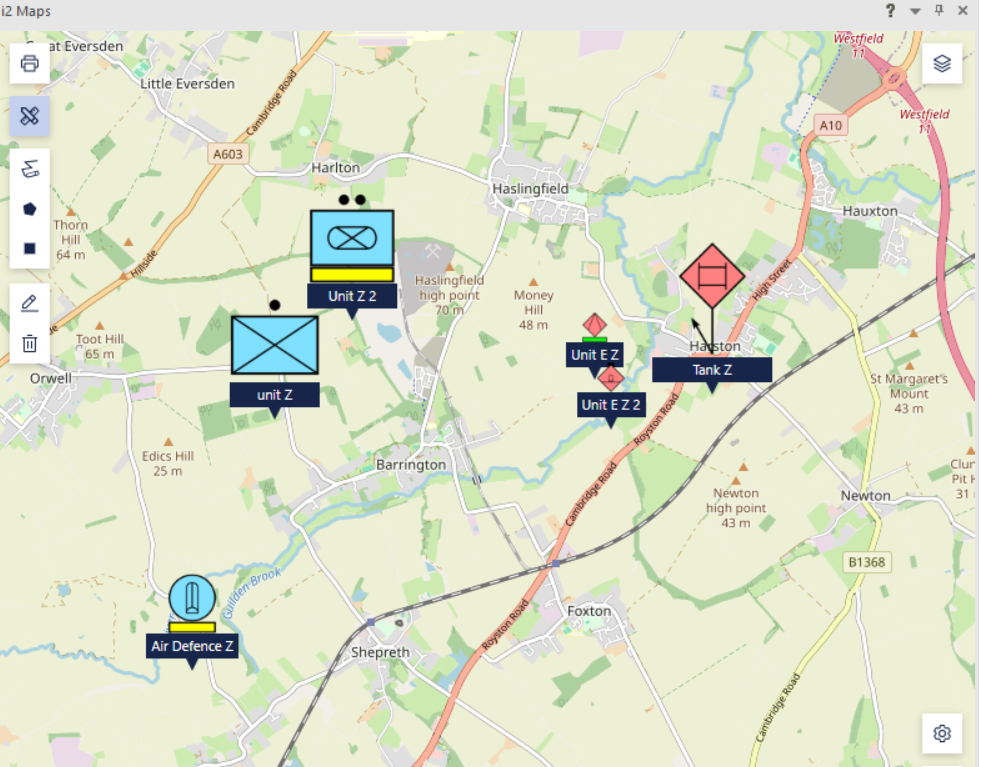
Marker_Position_updating
In this release you can now update the location of a marker from the map surface.
Note: This is only supported for latitudinal and longitudinal properties in iBase and chart items. i2 Analyze records use the geospatial property.
Polygon_Seeding
To accelerate our users' workflows we have added the ability to seed the new Drawable polygons that can now be used to seed queries in.
External Searches
With i2 Analyze version 4.4.5.2, a polygon can be seeded to any external search that supports a geospatial area.
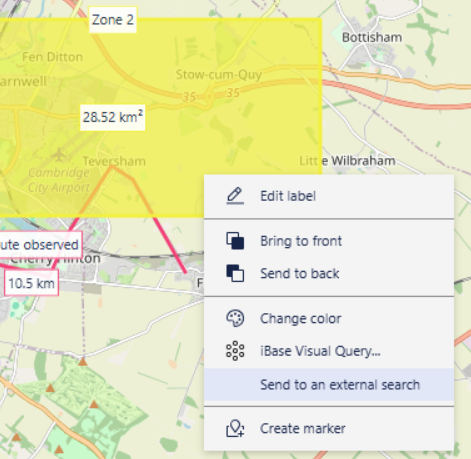
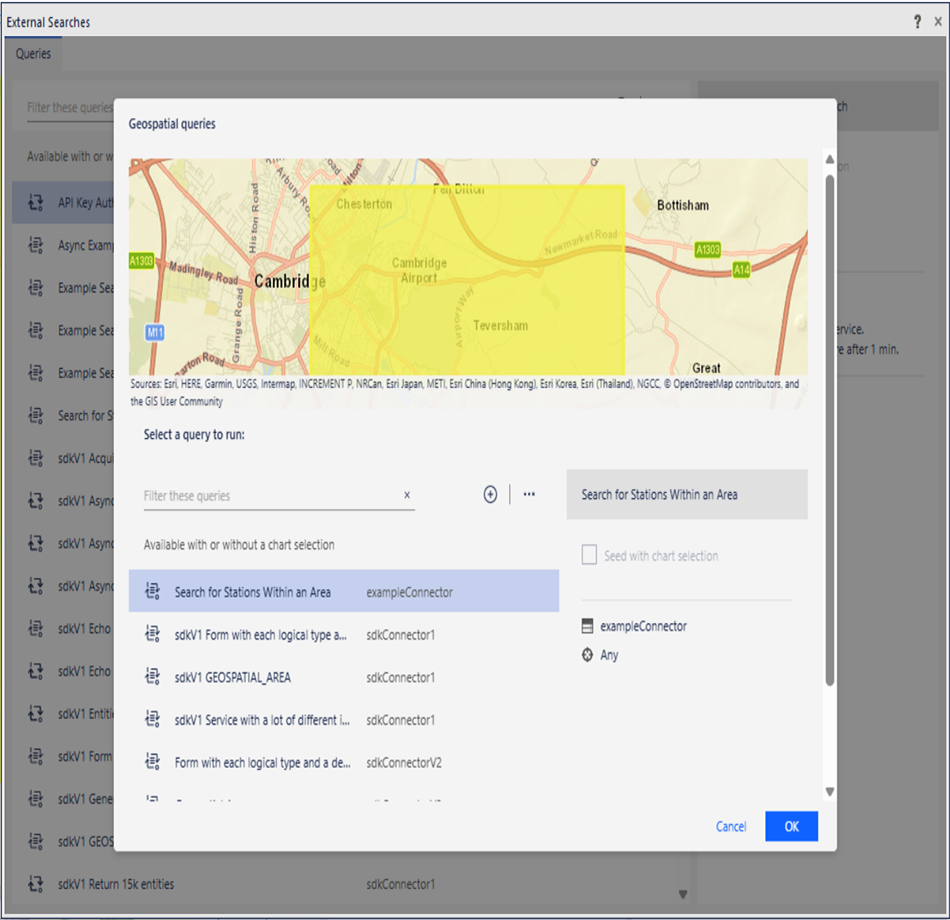
iBase
With iBase version 10.1.1 a polygon can be seeded into iBase for geospatial querying.
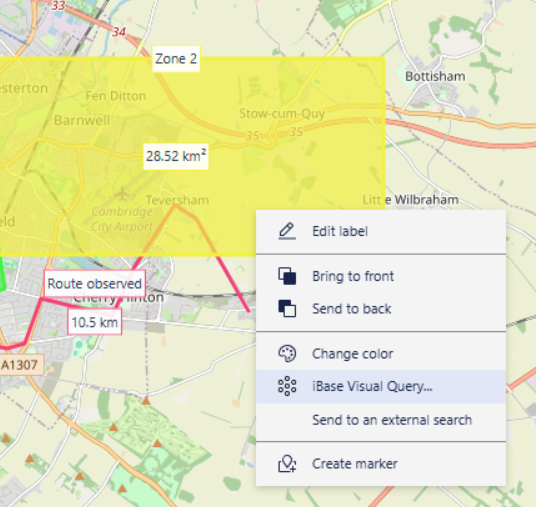
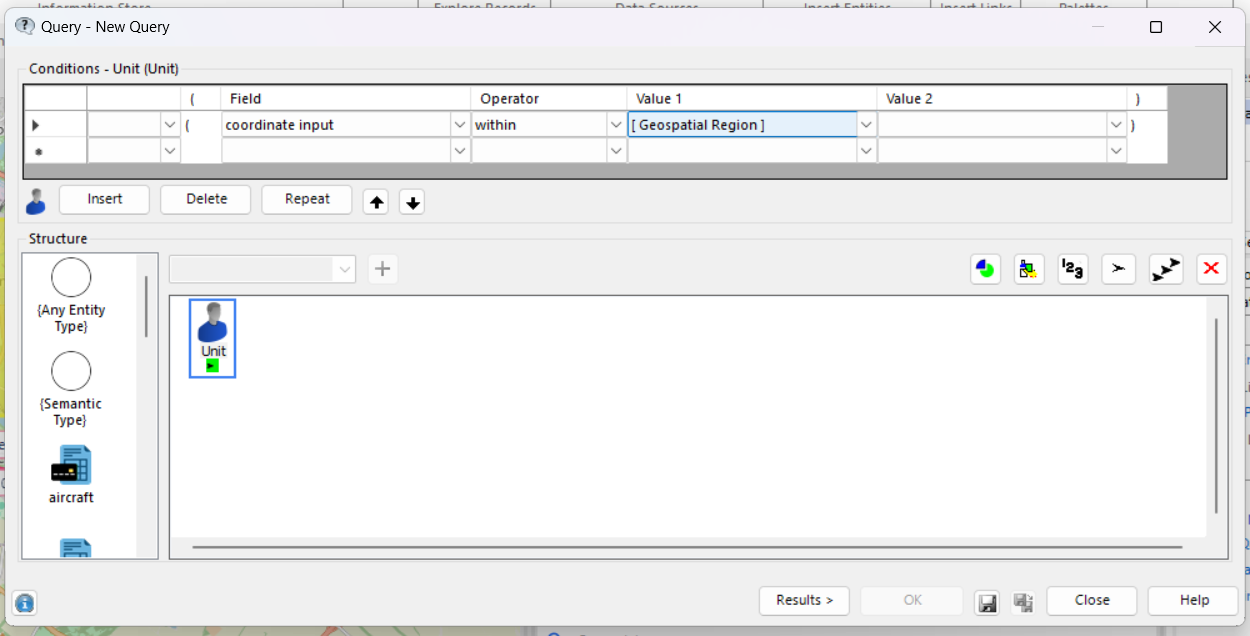
Print maps
In this release you can now print your map into PDF format.

Version by Version comparison
The following table shows a comparison of features between recent versions of Analyst's Notebook:
🆕 = New Feature
✅ = Existing Feature
❌ = Feature Removed/Obsolete
| FEATURES | i2 Overwatch 1.1.0 |
|---|---|
| APP6D | 🆕 |
| Drawing tools | 🆕 |
| Layers | 🆕 |
| Radii | 🆕 |
| Custom Tile Server support | 🆕 |
| Mapping Enhancements | 🆕 |
| Polygon Seeding | 🆕 |
| Print map | 🆕 |
Fixed and known issues
The issues that have been fixed in this release, and known issues.
Fixed issues
| Issue Number | Issue title |
|---|---|
| Not applicable |
Known issues
| Issue Number | Issue title |
|---|---|
| Not applicable |
Download information
Customers who have entitlement can request copies of i2 products.
For more information, see Where can I download the latest i2 products?
System requirements
The following tables shows the system requirements for this release, and previous releases. These system requirements should be used to ensure that the setup you are running is fully supported. Ensure that existing deployments are upgraded to currently supported versions of all the software required.
🆕 = Newly supported ✅ = Supported ❌ = No longer supported
Operating systems
| OPERATING SYSTEMS | i2 Overwatch 1.1.0 |
|---|---|
| Microsoft Windows 11 Enterprise x64 (64-bit) | ✅ |
| Microsoft Windows 11 Pro x64 (64-bit) | ✅ |
| Microsoft Windows 10 Enterprise x64 (64-bit) | ✅1 |
| Microsoft Windows 10 Pro x64 (64-bit) | ✅1 |
| Microsoft Windows Server 2022 Datacenter Edition | ✅ |
| Microsoft Windows Server 2022 Standard Edition | ✅ |
| Microsoft Windows Server 2019 Datacenter Edition | ✅ |
| Microsoft Windows Server 2019 Essentials Edition | ✅ |
| Microsoft Windows Server 2019 Standard Edition | ✅ |
| Microsoft Windows Server 2016 Datacenter Edition | ✅1 |
| Microsoft Windows Server 2016 Essentials Edition | ✅1 |
| Microsoft Windows Server 2016 Standard Edition | ✅1 |
1 Microsoft Windows 10 Pro amd Windows Server 2016 support will be deprecated in a future Analyst's Notebook release.
Note: i2 products are supported on hardware virtualization environments that run any of the operating systems that are listed in the detailed system requirements. When you run in a virtual environment, any issues that can be replicated by i2 in a supported operating system are addressed by using the standard support policy. Trial editions of i2 Analyst's Notebook cannot be run in virtualized environments.
Prerequisites
| SOFTWARE PREREQUISITES | i2 Overwatch 1.1.0 |
|---|---|
| i2 Analyst's Notebook 10.1.0 = FP 3 | ✅ |
Hardware
| Hardware requirements | Minimum | Recommended |
|---|---|---|
| Disk space | 1GB for installation plus additional working space | |
| Processor | Intel or AMD processor with 64-bit and SSE 4.2 support | |
| 2GHz or faster | ||
| Memory | 8GB | 16GB |
| Display | 1280 x 768 | 1920 x 1080 |
Language support
i2 products are tested on a number of various regional variations of operating systems. At this release, i2 Overwatch is not translated, and is available in English only.
Operating system language support
i2 supports this product on the following regional versions of the supported operating systems:
| Language Group/Language | Language Collection | Support Status |
|---|---|---|
| Western Europe and USA | Basic | ✅ |
| Central Europe | Basic | ✅ |
| Baltic | Basic | ✅ |
| Cyrillic | Basic | ✅ |
| Turkic | Basic | ✅ |
| Arabic | Complex Script | ✅ |
| Japanese | East Asian | ✅ |
| Korean | East Asian | ✅ |
| Traditional Chinese | East Asian | ✅ |
| Simplified Chinese | East Asian | ✅ |
| Thai | Complex Script | ❌ |
| Vietnamese | Complex Script | ❌ |
| Greek | Basic | ❌ |
| Hebrew | Complex Script | ❌ |
| Indic | Complex Script | ❌ |
| Georgian | Complex Script | ❌ |
| Armenian | Complex Script | ❌ |
| Dhivehi | Complex Script | ❌ |
| Galician | Complex Script | ❌ |
| Gujarati | Complex Script | ❌ |
| Kannada | Complex Script | ❌ |
| Kyrgyz | Complex Script | ❌ |
| Mongolian (Cyrillic) | Complex Script | ❌ |
| Punjabi | Complex Script | ❌ |
| Syriac | Complex Script | ❌ |
| Telugu | Complex Script | ❌ |
Data support
i2 products support unicode data.
Translations
The following languages are supported:
| Translations | i2 Overwatch |
|---|---|
| English | ✅ |